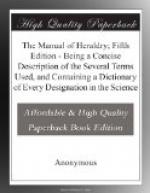MANTLING. The flowing drapery forming the scroll-work displayed on either side of the helmet from beneath the wreath, representing the ancient covering of the helmet, used to protect it from stains or rust. When the mantling incloses the escutcheon, supporters, &c., it represents the robe of honour worn by the party whose shield it envelopes. This mantle is always described as doubled, that is, lined throughout with one of the furs, as ermine, pean, vary. For examples of mantling, see the arms and crests of England, Scotland, and Ireland.
MARQUIS. The second order of nobility in England, next in rank to a duke.
MARSHAL. A title of honour. See EARL MARSHAL.
TO MARSHAL. To place persons in due order, according to their precedency, in public processions, such as coronations, proclamations of peace or war, funerals, &c.
MARSHALLING ARMS. The disposing of several coats of arms belonging to distinct families in the same escutcheon, together with their ornaments, parts, and appurtenances.
MARTLET. An imaginary bird said to be without legs; it is used both as a charge and a difference.
[Illustration: Martlet]
EX. Argent, a martlet, gules.
MASCLE. An open lozenge-shaped figure, one of the subordinate ordinaries.
[Illustration: Mascle]
EX. Argent, a mascle, vert.
MEMBERED. A term used to express the beak and legs of a bird when they are of a different tincture from its body.
MERCURY. The name of the planet, used by ancient heralds to describe purple in blazoning the arms of sovereigns.
METAL. The two metals used in Heraldry are gold and silver, called or and argent. It is against the rules of Heraldry to place metal upon metal, or colour upon colour, unless for special reasons. Therefore, if the field be of any colour, the bearing must be of one of the metals, and on the contrary, if the field be of one of the metals, the bearing must be of some colour.
MILLRIND. The iron placed in the centre of a grindstone to protect the hole in the centre from the action of the axis; it is a charge frequently borne on escutcheons of persons connected with agriculture.
[Illustration: Millrind]
EX. Argent, a millrind, gules.
[Illustration: MITRE.]
MITRE. A sacerdotal ornament for the head, worn by Roman Catholic archbishops and bishops on solemn occasions. Certain English abbots formerly wore mitres, and they are frequently found as charges in the arms of abbeys and monasteries. The annexed is a representation of the mitre of the archbishops and bishops of the church of England, borne as a mark of distinction over the arms of the see, or over their paternal achievements, when impaled with the arms of their see. The prelates of the Protestant Church of England never wear mitres.
[Illustration: MITRE.]
The Bishops of Durham were formerly princes of the Palatinate of Durham, and wore a ducal coronet surmounted by a mitre. They still retain the coronet and mitre as an heraldic distinction, borne over the arms of the bishopric.




